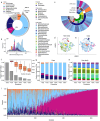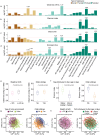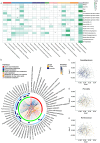The influence of early life exposures on the infant gut virome
- PMID: 40396485
- PMCID: PMC12101590
- DOI: 10.1080/19490976.2025.2501194
The influence of early life exposures on the infant gut virome
Abstract
The factors influencing the establishment of the gut bacterial community in early life are fairly well studied. However, the factors shaping the infant gut virome remain elusive. Interestingly, early life gut virome imbalances have recently been linked with increased risk of developing diseases like type 1 diabetes and asthma. We utilized the deeply phenotyped COPSAC2010 cohort to investigate how environmental factors influence the gut virome at one year age. We demonstrate that the presence of older siblings as well as residential location (urban or rural) had the strongest impact on gut virome composition at 1 year of age. A total of 16,118 species-level clustered viral representative contigs (here termed viral Operational Taxonomic Units - vOTUs) were identified and of these 2105 vOTUs varied in abundance with environmental exposures. Of these vOTUs 94.1% were phages mainly predicted to infect Bacteroidaceae, Prevotellaceae, and Ruminococcaceae. Strong co-abundance of phages and their bacterial hosts was confirmed underlining the predicted phage-host connections. Furthermore, we found some gut viruses affected by environmental factors encode enzymes involved in the utilization and degradation of major dietary components, potentially affecting infant health by influencing the bacterial host metabolic capacity. These findings provide a valuable insights for understanding the early life factors that predispose to autoimmune and metabolic disorders.
Keywords: Environmental exposures; bacterial host; gut microbiota; infant; metabolism; phage; virus.
Conflict of interest statement
No potential conflict of interest was reported by the author(s).
Figures




References
-
- Kostic AD, Gevers D, Siljander H, Vatanen T, Hyötyläinen T, Hämäläinen A-M, Peet A, Tillmann V, Pöhö P, Mattila I, et al. The dynamics of the human infant gut microbiome in development and in progression toward type 1 diabetes. Cell Host & Microbe. 2015;17(2):260–273. doi: 10.1016/j.chom.2015.01.001. - DOI - PMC - PubMed
MeSH terms
LinkOut - more resources
Full Text Sources
